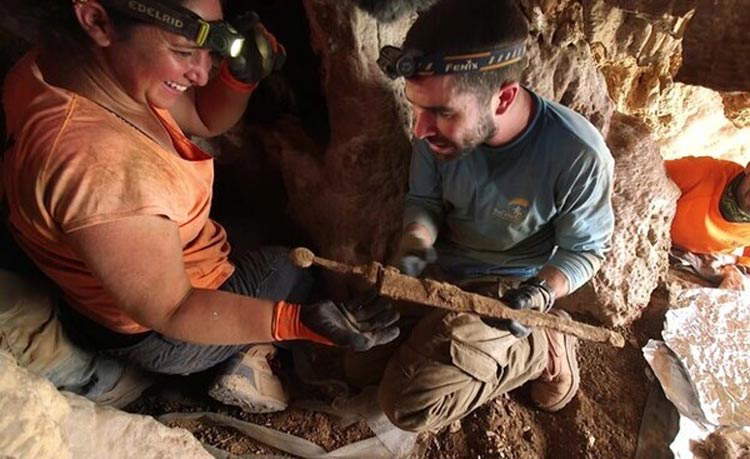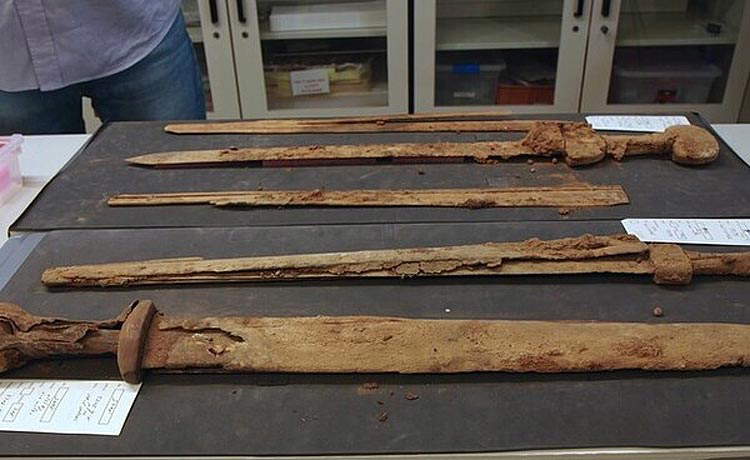Israel, important and rare archaeological discovery: four Roman swords found
Important discovery in Israel, announced yesterday in Jerusalem: four Roman swords and the head of a javelin were found in a cave in the Ein Gedi nature reserve on the shores of the Dead Sea during a routine survey made by a group of researchers who were in the area to take surveys. These could be, according to the researchers who studied the findings, elements of a war booty that some Jewish rebels took from the Romans during a raid. The caves that open along the shores of the Dead Sea were in fact habitual hiding places for Jewish rebels: the swords date, according to scholars, to the first century A.D., at the time of the conquest of the annexation of Judea to the Roman Empire.
In the same cave, about 50 years ago, the remains of a Hebrew inscription were discovered on a stalactite, made with ink using the ancient form of writing from the First Temple period (10th-5th centuries BCE). It is located north of Ein Gedi, within the reserve, in an isolated rocky area that is difficult to access. The discovery of the swords is also considered exceptional because it is linked to the very discovery of these inscriptions: Dr. Assaf Gayer of the Department of Archaeology at Ariel University, geologist Boaz Langford of the Institute of Earth Sciences and the Center for Cave Research at the Hebrew University of Jerusalem, and Shai Halevi, a photographer from the IAA, the Department of Antiquities, had in fact gone to the cave with the goal of photographing it, employing multispectral photography to decipher some parts not visible to the naked eye.

In the course of this operation, while in the upper part of the cave, Dr. Geyer found in a deep, narrow area the head of the javelin in an extraordinary state of preservation, and in a crevice not far away he also found some pieces of worked wood that turned out to be part of the scabbards of the swords. Following the find, the researchers reported the discovery to the IAA’s research team in charge of this specific subject, which went to the cave together with Dr. Geyer and Langford for a careful analysis of all the crevices.
During this second exploration, in a narrow and deep crevice located between two stalactites, the researchers discovered the four anciently concealed and excellently preserved swords from the Roman period: three of them were even found inside their respective scabbards, made of wood and leather and with some metal parts.
At the basis of the incredible state of preservation are the temperature and reduced humidity conditions guaranteed by the cave, which stopped the deterioration of the non-metal parts, allowing us to find very well-preserved wooden parts of the handles of the swords as well.

The blade length of three swords is about 60-65 cm, a fact that allows them to be classified as “Roman Spatha,” a particular weapon provided with a longer blade than the gladius, which usually had a length of around half a meter or slightly more (the spatha, on the other hand, could have a blade of even 80-100 centimeters). It was a weapon usually used by legionaries on horseback, who needed a longer blade to strike enemies who were further away. The fourth blade, on the other hand, measures 45 centimeters, a length that makes it ascribable to the type of ring-pommel swords. Overall, analysis of the findings after they were assembled led to the understanding that the weapons found are standard swords used by soldiers of the army stationed in the Land of Israel during the Roman period.
“The concealment of the swords and javelin head inside deep crevices of an isolated cave north of Ein Gedi,” explains Dr. Eitan Klein, director of the Judean Desert Survey Project, “suggests that the weapons were taken as booty from Roman soldiers or carried away from the battlefield and were deliberately hidden by Jewish rebels so they could be reused. It is likely that the rebels did not want to be caught with the weapons on them in the event of a confrontation with the Roman authorities. We are only at the beginning of the research journey related to this cave and the set of weapons found inside, and our goal is to try to find out who the swords belonged to, where they were made, when, and by whom. We will try to understand what historical event led to the removal of the weapons from the cave, and whether it could be connected to the Bar Kochba rebellion that took place between 132-135 AD. This discovery that touches a historical moment is chilling and exciting. Not everyone knows that due to dry weather conditions, artifacts are preserved in the desert that have not survived in other parts of the country. This is a very unique time capsule.”
 |
| Israel, important and rare archaeological discovery: four Roman swords found |
Warning: the translation into English of the original Italian article was created using automatic tools. We undertake to review all articles, but we do not guarantee the total absence of inaccuracies in the translation due to the program. You can find the original by clicking on the ITA button. If you find any mistake,please contact us.





























